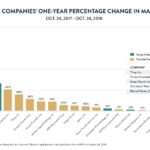Fresh Perspectives Arising from the Pacific Rim

Investors Waking Up to Hemp as Cannabis Stocks Retrace
October 31, 2018
Cannabis Initiatives Pass in Three of Four States in Mid-term Election Cycle
November 7, 2018By J.J. McCoy, Senior Managing Editor, New Frontier Data
The Asia-Pacific region is home to 60% of the world’s population – some 4.3 billion people – including the world’s most populous country, China. To suggest that it offers a modern-day Silk Road for investment and development connecting the East and West is an understatement to anyone who does the math: That is a potential market more than 13x larger than that of the United States.
Suffice to say, it is positioned to dominate world hemp production for years to come. The Asian markets have the potential to provide for some of the world’s greatest consumers of hemp and CBD goods; understanding the unique market dynamics and regulatory landscape is essential for investors or prospective market entrants looking to capitalize on the opportunities there.
While unrelated disputes on Capitol Hill have hindered American production, Asian-Pacific nations are seeking out the waves of demand. New Frontier Data’s latest release, Asia-Pacific Hemp Brief: 2018 Overview, provides analysis of key developments shaping the hemp markets specifically in the China and the Asia Pacific regions, identifying some of the sectors likely to present the greatest opportunities as the contemporary market matures.
Given both its size and cultural experience of centuries’ worth of cultivation of cannabis sativa for the plant’s strong fibers used to manufacture paper, fabric, and rope, it is not surprising that China is the world’s leader in hemp cultivation, processing, manufacturing, and exports. Until recently, China maintained half of the world’s total planting area for industrial hemp, along with half of the world’s cannabis-related patents. In 2017, Chinese domestic consumer sales of hemp were estimated at $1.1 billion (USD), or more than 1/3 of the global market. Already boasting such a substantial hemp-derived textile industry, the country’s growing CBD market is likewise poised to dominate as consumers become more familiar with the increasingly destigmatized product’s versatility.
Along with New Frontier Data’s research and analysis of new data inputs, changes in regulations, expansion of regulation into new markets, and other market-moving events, industry analysts conducted primary interviews with owners and operators in both China and the U.S. to understand in-country dynamics and gather data about the supply chain. The new overview includes looks into Japan, South Korea, and Thailand, and updates about the Philippines and Malaysia.
As the markets for hemp and CBD throughout the Asia Pacific region continue to evolve, it will be increasingly important to closely follow developments closely and continuously consider potential opportunities as they arise. Much of how the industry landscape’s prospective shape will come into focus will depend on dynamics including the speed of respective markets’ expansion, and how quickly long-held traditional views are re-established to help the local governments move forward with their planned regulatory changes.




